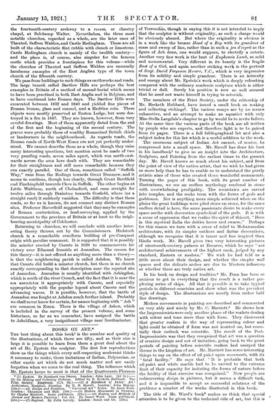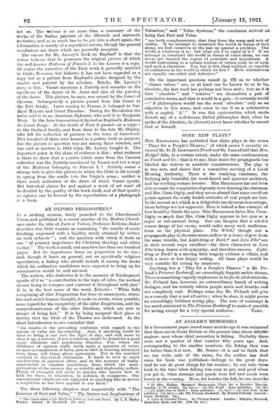BOOKS ON ART.*
Tan best thing about this book' is the number and quality of the illustrations, of which there are fifty, and as their size is large it is possible to learn from them a great deal about the art of Mr. Epstein the sculptor. The first few reproductions show us the things which every sell-respecting modernist thinks it necessary to make, those imitations of Indian, Polynesian. or other exotic art which do not much matter and are easily forgotten when we come to the real thing. The influence which Mr. Epstein keeps to most is that of the Quattrocento Florence * (1) Epstein. By Bernhard van Dieren. London : John Lane. (82 2s.}-- (2) On Making and Collecting Etchings. Edited by E. Hc,keth Hubbard. The Print Society. Ringwood. (175. ad.1---(1) d Handbook of mils': Art: Architecture. Sculpture. Painting. By E. 33. Havell. London : John Murray. 1258.3—(4) Design and Tradition. " Universal Art" Series. By Amor Fenn. London: Chapman and Hall. ES0s.J---(5) Modern Movements in Painting. By Charles Marriott. Same publishers. [21s.]—(0) History and Methods of Ancient and Modern Painting : Vol. III. By James Ward. Same publishers. I15s.]—(7) Raphael. By Felix Lavery. London: Sands and Co. 1218.3 of Verrecchia, though in saying this it is not intended to imply that the sculptor is without originality, as such a charge would be obviously absurd. But where the originality is obvious is in a work like the bronze Head of a Boy with its grandeur of mass and sweep of line, rather than in such a jeu d'esprit as the figure of Job done, one would suppose, to electrify a coterie. Another very fine work is the bust of Euphemia Lamb, so solid and monumental. Very different in its beauty is the fragile Bust of a Girl, and again another striking work is the portrait of Serge. David Ferguson Hunter, V.C., which is very impressive from its solidity and simple grandeur. There is an intensity. and energy about Mr. Epstein's work which is deeply refreshing compared with the ordinary academic sculpture which is either trivial or dull. Surely his position is now so well secured that he need not waste himself in trying to astonish.
The members of the Print Society, under the editorship of Mr. Hesketh Hubbard, have issued a small book on making and collecting etchings2. The various essays are by no means exhaustive, and an attempt to make an aquatint with only Miss Stella Langdale's chapter to go by would be to invite failure. At the same time the various parts of the book are all written by people who are experts, and therefore light is to be gained from its pages. There is a full bibliographical list and also a subject index for this list which is a useful addition to the work.
The enormous subject of Indian Art cannot, of course, he compressed into a small space. Mr. Havell has done his beet in his handbook3 to give us an insight into the Architecture, Sculpture, and Painting from the earliest times to the present day. Mr. Havell knows so much about his subject, and from the point of view of the native artist, that we wish he had given us more help than he has to enable us to understand the purely artistic aims of those who created these wonderful monuments. Turning the pages of this book, with its great number of illustrations, we see an endless mythology rendered in stone with overwhelming prodigality. The mountains are carved into temples, and the rocks teem with the forms of gods and goddesses. Nor is anything more simple achieved when on the plains the great buildings were piled stone on stone, for the samo endless detail is here, the same passionate desire to make every space seethe with decoration symbolical of the gods. It is with a sense of oppression that we realize the spirit of this art, "Hero in this mystical India the deities hover and swarm." Perhaps for this reason we turn with a sense of relief to Mohammedan architecture, with its simpler outlines and flatter decorations, although we recognize that it is tamer and less inspired than Hindu work. Mr. Havell gives two very interesting pictures of nineteenth-century palaces at Benares, which he says " are architectural achievements of the highest rank, judged by any standard, Eastern or modern." We wish be had told us a little more about their design, and whether the simpler well spaces and the delicate arches are due to Western influence; or whether these are truly native art.
In his book on design and tradition4 Mr. Fenn has been so anxious to get in everything that the result is a rather per- plexing series of skips. All that is possible is to take typical periods in different countries and show what was the prevalent style of design. The illustrations are mostly from rather bald line drawings.
Modern movements in painting are described and commented on very ably and wisely by Mr. C. Marriott.5 He shows how the Impressionists were only another phase of the realists dealing with colour and tone more than with form. They discovered that greater realism in the way of representing colour and light could be obtained if form was not insisted on, but essen- tially their outlook was scientific. The revolt of the Post- Impressionists was that they recognized that art was a question of creative design and not of imitation, going back to the great periods of painting before scientific realism had usurped the throne in the kingdom of art. Mr. Marriott has some interesting things to say on the effect of oil paint upon movements, with its " fatal facility." He says that " It is probable that both oil-paint and white marble had to be carried to the extreme limit of their capacity for imitating the forms of nature before the futility of that exercise was recognized." Now people are rediscovering design in pictures, but it seems a difficult task, and it is impossible to accept as successful solutions of the problems a number of the works illustrated in this book.
The title of Mr. Ward's book' makes us think that special attention is to be given to the technical side of art, but this is not so. The volume is no more than a summary of the works of the Italian painters of the fifteenth and -sixteenth centuries; and as so much has to be got into a short space, the information is mostly of a superficial nature, though the general conclusions are those which are generally accepted.
The excuse for Mr. Lavery's book on Raphael' is that the writer believes that he possesses the original picture of which the well-known Madonna of Francis I. in the Louvre is a copy. Of course the execution of the Paris work is generally ascribed to Giulio Romano, but hitherto it has not been regarded as a copy but as a picture from Raphael's studio designed by the master and painted by the scholars. Briefly, Mr. Lavery's story is this. Vasari mentions a Nativity and remarks on the excellence of the figure of St. Anne and also of the painting of the dawn. This picture, he says, was owned by the Count of Canossa. Subsequently a picture passed from this Count to the Este family. Later coming to France, it belonged to Car-. dinal Mazarin and Count Pimodan. During the Revolution the latter sold it to an American diplomat, who sold it to Benjamin West. In the later transactions it figured as Raphael's Madonna du Corset Rouge. At the death of West it passed—as a copy— to the Garland family, and from them to the late Mr. Shipley, who left his collection of pictures to the town of Gateshead. Five hundred of these were housed in a gallery built on purpose, but the picture in question was not among those selected, and was sold at auction in 1914 when •Mr. Lavery bought it. The important point in the chain of evidence is this : what evidence is there to show that a Taiture which came from the Canossa collection was the Nativity mentioned by Vasari and not a copy of the Madonna belonging to Francis I. ? Nativity seems a strange title to give this picture in which the Child is old enough to spring from the cradle into the Virgin's arms ; neither is there much indication of the dawn of which Vasari speaks. But historical claims for and against a work of art must all be decided by the quality of the work itself, and of that quality no opinion can be formed by the reproduction of a photograph in a book.































 Previous page
Previous page